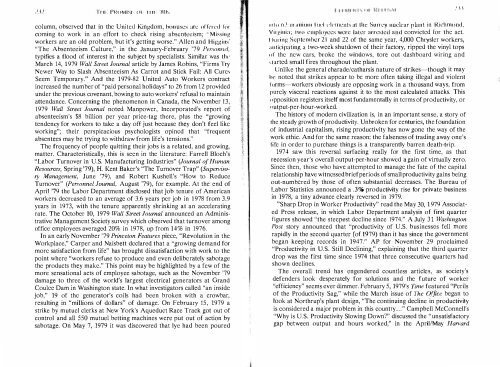CONTENTS - ouroboros ponderosa
CONTENTS - ouroboros ponderosa
CONTENTS - ouroboros ponderosa
Create successful ePaper yourself
Turn your PDF publications into a flip-book with our unique Google optimized e-Paper software.
"u. 'rilL PH( )M1SI ". (H' Ti ll' 'XO'<br />
column, observed that in the U nited Kingdom, nOllusl:s (.Ire ol'fered Ill!<br />
coming to work in an effort to check rising absenkcism; "Missill)!,<br />
workers are an old problem, but it's gctting worse." Allen and Higgills'<br />
"The Absenteeism Culture," in thc January-February '79 Pers(}ntu'l.<br />
typifies a flood of interest in the subject by specialists. Similar was thl"<br />
March 14, 1979 Wall Slreet Journal article by James Robins, "Firms Try<br />
Newer Way to Slash Absenteeism As Carrot and Stick Fail: All Cures<br />
Seem Temporary_" And the 1979-82 United Auto Workers contract<br />
increased the number of "paid personal holidays" to 26 from 12 provided<br />
under the previous covenant, bowing to auto workers' refusal to maintain<br />
attendance. Concerning the phenomenon in Canada, the November 13,<br />
1979 Wall Street Journal noted Manpower, Incorporated's report of<br />
absenteeism'S $8 billion per year price-tag there, plus the "growing<br />
tendency for workers to take a day off just because they don't feel like<br />
working"; their perspicacious psychologists opincd that "frequent<br />
absentees may be trying to withdraw from life's tensions,"<br />
The frequency of people quitting their jobs is a related, and growing,<br />
matter. Characteristically, this is seen in the literature: Farrell Bloch's<br />
"Labor Turnover in U.S, Manufacturing Industries" (Journal oj Human<br />
Resources, Spring '79), H. Kent Baker's "The Turnover Trap" (Superviso<br />
ry Management, June '79), and Robert Kushell's "How to Reduce<br />
Turnover" (Personnel Journal, August '79), for example. At the end of<br />
April '79 the Labor Department disclosed that job tenure of American<br />
workers decreased to an average of 3.6 years per job in 1978 from 3.9<br />
years in 1973, with the tenure apparently shrinking at an accelerating<br />
rate. The October 10, 1979 Wall Street Journal announced an Adminis<br />
trative Management Society survey which observed that turnover among<br />
offIce employees averaged 20% in 1978, up from 14% in 1976.<br />
In an early November '79 Princeton Features piece, "Revolution in the<br />
Workplace," Carper and Naisbett declared that a "growing demand for<br />
more satisfaction from life" has brought dissatisfaction with work to the<br />
point where "workers refuse to produce and even deliberately sabotage<br />
the products they make_" This point may be highlighted by a few of the<br />
more sensational acts of employee sabotage, such as the November '79<br />
damage to three of the world's largest electrical generators at Grand<br />
Coulee Dam in Washington state. In what investigators called "an inside<br />
job," 19 of the generator's coils had been broken with a crowbar,<br />
resulting in "millions of dollars" of damage. On February 15, 1979 a<br />
strike by mutuel clerks at New York's Aqueduct Race Track got out of<br />
control and all 550 mutuel betting machines wcre put out of action by<br />
sabotage, On May 7, 1979 it was discovered that lye had been poured<br />
illhl (I.'. uralliulII I"Ul'l l'll"IllCllts at the Surrey nuclear p lan t in Richmond,<br />
Viq.',illiOl; lw() emploYl:cs were later arrested amJ convicted for the act.<br />
I lUling Septemher 21 and 22 of the same year, 4,000 Chlyslcr workers,<br />
:ullicirating a two-week shutdown of their factory, ripped the vinyl tops<br />
"r the new cars, brokc the windows, tore out dashboard wiring and<br />
started small fires throughout the plant.<br />
Unlike the general charade/catharsis nature of strikes-though it may<br />
he noted that strikes appear to be more often taking illegal and violent<br />
fllrms-workers obviously are opposing work in a thousand ways, from<br />
I'lITely visceral reactions against it to the most calculated attacks. This<br />
opposition registers itself most fundamentally in tcrms of productivity, or<br />
(,utput -per-hour -worked.<br />
The history of modern civilization is, in an important sense, a story of<br />
the steady growth of productivity. Unbroken for centuries, the foundation<br />
of industrial capitalism, rising productivity has now gone the way of the<br />
work ethic_ And for the same reason: the falseness of trading away one's<br />
tife in order to purchase things is a transparently barren death-trip,<br />
1974 saw this reversal surfacing really for the first time, as that<br />
recession year's overall output-per-hour showed a gain of virtually zero.<br />
Since then, those who have attempted to manage the fate of thc capital<br />
relationship have witnessed brief periods of small productivity gains being<br />
out-numbered by those of often substantial decreases. The Bureau of<br />
Labor Statistics announced a .3% productivity rise fo r private business<br />
in 1978, a tiny advance clearly reversed in 1979.<br />
"Sharp Drop in Workcr Productivity" read the May 30, 1979 Associat<br />
ed Prcss release, in which Labor Department analysis of first quarter<br />
figures showed "the steepest decline since 1974." A July 31 Washington<br />
Po st story announced that "productivity of U_S. businesses fell more<br />
rapidly in the second quarter (of 1979) than it has since the government<br />
began keeping records in 1947," AP for November 29 proclaimed<br />
"Productivity in U.S. Still Declining," explaining that the third quarter<br />
drop was the first time since 1974 that three consecutive quarters had<br />
shown declines.<br />
The overall trend has engendered countless articles, as society's<br />
defenders look desperately for solutions and the future of worker<br />
"efficiency" seems ever dimmer. February 5, 1979's 'time featured "Perils<br />
of the Productivity Sag," while the March issue of 1he Office began to<br />
look at Northrup's plant design, "The continuing decline in productivity<br />
is considered a major problem in this country .... " Campbell McConnell's<br />
"Why is U,S_ Productivity Slowing Down'!" discussed the "unsatisfactory<br />
gap between output and hours worked," in the April/May Harvard<br />
.' \ \






